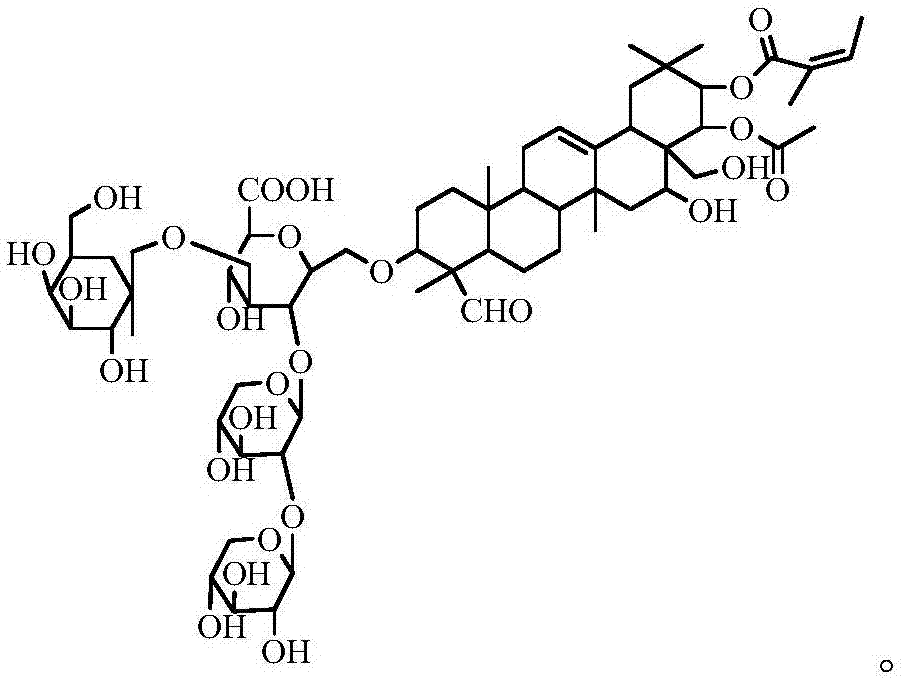Tea saponin modified red mud and composite floor tile made from red mud and waste plastics
A technology of waste plastics and tea saponin, which is applied in the field of building materials, can solve the problems of white pollution, poor compatibility of two phases, and land occupation, etc., and achieve the effects of increasing the number of filling parts, good dispersion performance, and improved combination
- Summary
- Abstract
- Description
- Claims
- Application Information
AI Technical Summary
Problems solved by technology
Method used
Image
Examples
Embodiment 1
[0048] Make tea saponin modified red mud according to the following steps:
[0049] Add 93Kg of red mud and 7Kg of tea saponin into a high-speed mixer at 50°C, and stir for 7 to 9 minutes to obtain tea saponin-modified red mud.
[0050] Follow the steps below to make composite floor tiles:
[0051] a. After cleaning 140Kg of waste polyphenylene ether plastics, dry them at 120°C for 1.4 hours, and then crush them to less than 7mm to obtain product A;
[0052] b. After mixing product A and 860Kg tea saponin modified red mud with a high-speed mixer, product B is obtained;
[0053]c. Put product B on a three-roller mill to form a sheet at a temperature of 260-290°C and a sheet thickness of 0.5-0.8mm, and then send it to a hot press for molding at a temperature of 120°C-150°C and a pressure of 7.0 MPa, the time is 3 to 5 minutes, and the product C is obtained;
[0054] d. Cut product C into pieces according to the standard size of 300mm in length, 300mm in width and 1.5mm in thi...
Embodiment 2
[0078] Make tea saponin modified red mud according to the following steps:
[0079] Add 90Kg of red mud and 10Kg of tea saponin into a high-speed mixer at 50°C, and stir for 7 to 9 minutes to obtain tea saponin-modified red mud.
[0080] Follow the steps below to make composite floor tiles:
[0081] a. After cleaning 200Kg of waste polyphenylene ether plastics, dry them at 120°C for 1.4 hours, and then crush them to less than 7mm to obtain product A;
[0082] b. After mixing product A and 800Kg tea saponin modified red mud with a high-speed mixer, product B is obtained;
[0083] c. Put product B on a three-roller mill to form a sheet at a temperature of 260-290°C and a sheet thickness of 0.5-0.8mm, and then send it to a hot press for molding at a temperature of 120°C-150°C and a pressure of 7.0 MPa, the time is 3 to 5 minutes, and the product C is obtained;
[0084] d. Cut product C into pieces according to the standard size of 300mm in length, 300mm in width and 1.5mm in t...
Embodiment 3
[0107] Make tea saponin modified red mud according to the following steps:
[0108] Add 87Kg of red mud and 13Kg of tea saponin into a high-speed mixer at 50°C, and stir for 7 to 9 minutes to obtain tea saponin-modified red mud.
[0109] Follow the steps below to make composite floor tiles:
[0110] a. After cleaning 250Kg of waste polyphenylene ether plastics, dry them at 120°C for 1.4 hours, and then crush them to less than 7mm to obtain product A;
[0111] b. After mixing product A and 750Kg tea saponin modified red mud with a high-speed mixer, product B is obtained;
[0112] c. Put product B on a three-roller mill to form a sheet at a temperature of 260-290°C and a sheet thickness of 0.5-0.8mm, and then send it to a hot press for molding at a temperature of 120°C-150°C and a pressure of 7.0 MPa, the time is 3 to 5 minutes, and the product C is obtained;
[0113] d. Cut product C into pieces according to the standard size of 300mm in length, 300mm in width and 1.5mm in t...
PUM
 Login to View More
Login to View More Abstract
Description
Claims
Application Information
 Login to View More
Login to View More - R&D
- Intellectual Property
- Life Sciences
- Materials
- Tech Scout
- Unparalleled Data Quality
- Higher Quality Content
- 60% Fewer Hallucinations
Browse by: Latest US Patents, China's latest patents, Technical Efficacy Thesaurus, Application Domain, Technology Topic, Popular Technical Reports.
© 2025 PatSnap. All rights reserved.Legal|Privacy policy|Modern Slavery Act Transparency Statement|Sitemap|About US| Contact US: help@patsnap.com



